Xi'an, Chongqing and Chengdu: quickfire tourist review
A no-frill review for people planning to visit, from my experience in China
Josh and I went on a two-week vacation to China this November, more specifically the three cities of Xi’an 西安, Chongqing 重庆, and Chengdu 成都. It is a trip that we hadlooked forward to for quite some time, and we did enjoy it quite a bit. I had too many impressions about these cities - the more proper, literary, and well-thought-out of which would deserve their own post later - so I figure I’d also make a short, no-frill review of everything. This would be great for you, dear reader, if you are planning to travel to China and these cities - otherwise, it’s not terrifyingly exciting. Maybe, then, my upcoming impressions posts will be more entertaining for you.
There might already be many guides you can find online, but more reviews are always a good thing, aren’t they? Much has changed in China over the past year, and updated information certainly can’t hurt. Save this post if you feel like going in the future!
Pretty photos all courtesy of Josh.
I. General notes for preparation
Payment: as should be obvious by now, our biggest frustrations were with payment. QR code payment, mainly Alipay 支付宝 and WeChat Pay 微信支付, is ubiquitous in China; even roadside stalls have them, and oftenit is impossible to pay with any other means. Until recently, you needed a Chinese mainland bank account to use these services.
Even as Alipay and WeChat Pay started accepting foreign bank cards this year, the support is not perfect. Sometimes, our VISA cards were arbitrarily blocked with no reason provided other than “security risk.” Because we did not have a local phone number, we could not contact customer service. So just because it works now does not guarantee that it will work later.
The single biggest piece of advice we could give is to not make any assumptions. We changed a lot of paper cash because we assumed that it could be used as a last resort; many places, including street vendors, simply don’t accept cash these days! OCBC announced it had Alipay+ integration, and so I did not set up Alipay but it turned out not to be supported by the majority of QR codes we encountered in Xi’an (though we had better luck in Chengdu); this meant I had to rely on Josh’s Alipay account a lot. Josh also applied for a DBS UnionPay card, but many Chinese mobile phone apps only accept Chinese mainland UnionPay cards - quite a way for UnionPay to shoot itself in the foot.
The best way to prepare is to install and set up both before you go. Have multiple bank cards set up in both apps. We recommend also having a Wise account and setting up your Wise VISA card with both apps; Wise’s security verification functions were the most reliable in our experience, while many Singaporean bank apps such as DBS and OCBC often took too long to load or were buggy, leading to denied transactions in public transport and restaurants.WeChat: WeChat was originally a messaging platform, but in addition to texts and payments, it is used to facilitate literally every type of transaction imaginable in China. We mean every: the WeChat QR code scanner is used for multiple things, from getting tickets at public museums, reading tourist guides, or ordering food in hotpot restaurants. You must set up WeChat, with OTP verified and bank cards added, before you go.
Maps: Baidu Maps is really the most accurate map service in China. If you need an English language interface, Apple Maps has been useful enough; after all, Apple has a substantial presence in China. In China, Google Maps is often inaccurate and unhelpful, and must be avoided at all costs.
Transport: all three cities have well-functioning and extensive metro networks, for which you can easily buy tickets using QR code pay or cash. For cars, Didi is the local ride-hailing equivalent - be sure to link your Alipay or WechatPay as payment method for convenience. For train tickets in between cities, we use high-speed rail/高铁. We highly recommend booking your tickets through China Highlights, where Fabio helped us find the best schedules and arranged everything for us with a reasonable service fee.
Language: People will generally struggle with English, so a bit of Chinese to order food, count numbers, and understand basic daily commands will make everything easier. People in Chengdu, especially the young, are quite competent in English, the other places not so much. In Chengdu also public areas and museums all have pretty good English translations, not so much the other two cities.
Translation apps helped us a lot, and Apple’s image-to-text functions were very useful. However, if you don’t know at least a bit of Chinese, you will have a very hard time!
Here are some important phrases:我要一碗/一盘(···)wo yao yi wan / yi pan (…) - I would like a bowl / a plate of…
这个多少?zhe ge duo shao? - How much is this?
我要一张票/我们要两张票。wo yao yi zhang piao / women yao liang zhang piao. - I would like one ticket / We would like two tickets.
我是外国人,没有中国号码。wo shi waiguoren, meiyou zhongguo haoma. - I am a foreigner, I don’t have a Chinese phone number. (Many WeChat forms for visiting museums, entering nightclubs, etc. require Chinese mainland phone numbers and seem to be designed without any way for foreigners to use them, so you might need help from staff to come in!)
Internet: Make sure everyone has a SIM or eSIM card with a sufficient amount of data allowance. It would also be a huge quality-of-life improvement to have a WiFi hotspot with unlimited internet, and if you are a foreigner, it is also helpful to have a VPN to keep access to English-language social media. From Singapore, one place to get both is from Changi Recommends.
Clothing: Check the weather for the time of year you go! Josh is a very tropical boy, and in Xi’an he had to wear five layers of shirts and a down coat.
II. Xi’an 西安
General vibe: chill city, with a lot of history and an interesting mix of cuisine. Rather cold in November (1-12 degrees C).
Accommodation: We wanted to treat ourselves a little bit ;) so we splurged on the Westin Xi’an because of its very striking architecture. Great hotel, although a tad slightly disappointing considering the price.
Places we recommend:
Dayanta 大雁塔 (Big Wild Goose Pagoda), the Dayanta Square, and the surroundings: great neighborhood, beautiful temples and gardens, with great city view. At night, the place lights up and gets very busy.
Bell Tower 钟楼, Drum Tower 鼓楼, Muslim Quarter: The cornerstone of the districts within the city wall. The towers are great sights to see and also have hourly performances. Lots of food. Get food from Miaohoujie, Sanjiaojie or Dapiyuan, they have better food than the main touristy street nearby.
Huaqing Palace 华清宫: if you’re back from your way to the Qinshihuang museum, you can take a shuttle bus to Huaqing Palace, which is very pretty and also has cable cars to the mountain nearby - we really enjoyed it.
Qujiang Lake 曲江池: a very nice park with great walking trails and beautiful sceneries of some traditional Chinese pavilions.

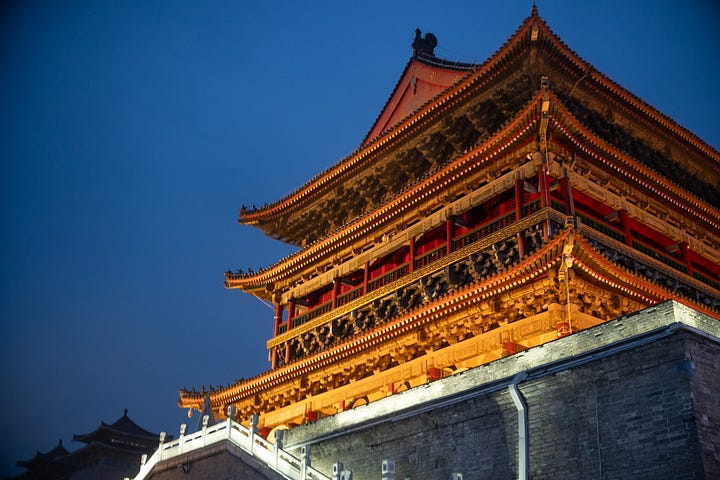
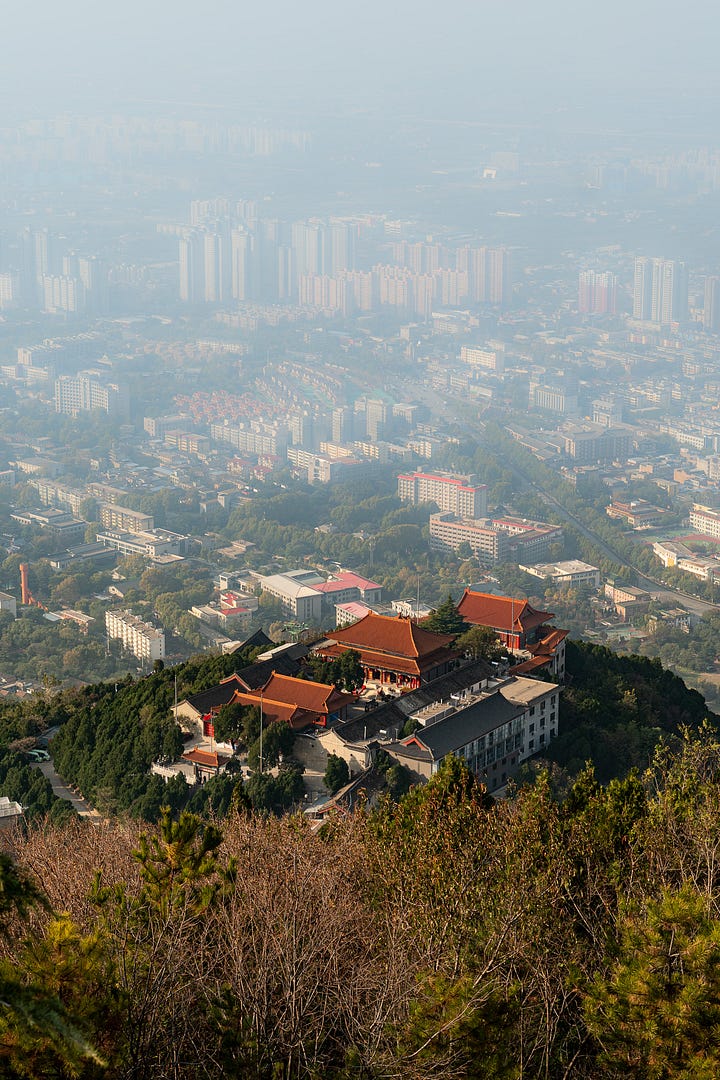
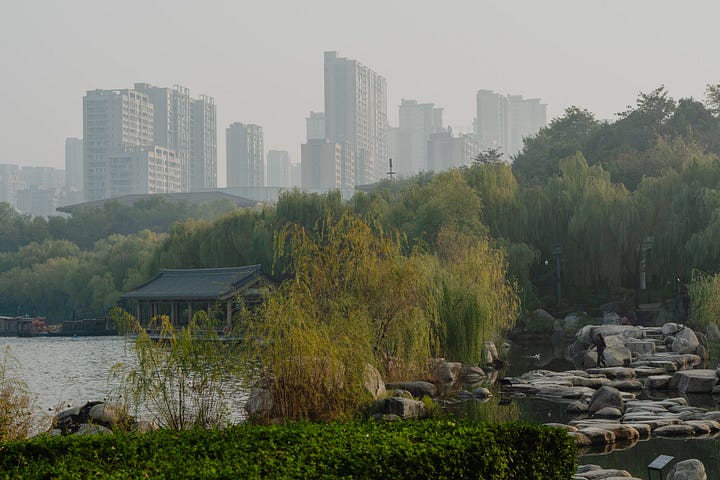
Food to try:
Roujiamo 肉夹馍: a.k.a “Chinese hamburgers”, probably the best takeaway food. Warm, hearty, and the perfect size for a snack. Pair with liangpi for a full meal.
Liangpi 凉皮: Cold, very refreshing noodles, can be served with a heartier sesame paste or just light oil dressing with cucumbers. Tastes good even in cold weather.
Yangrou Paomo 羊肉泡馍: Lamb soup with bread pieces inside. Honestly all lamb dishes have been quite incredible.
Xiaosurou 小酥肉: our favorite discovery: very fatty lamb stew that is perfect with rice on a cold evening. Not that popular of a dish though, but all the more reason to have this underrated dish! Go to the spot in Dapiyuan.
Biangbiangmian: Big flappy noodles that are infamous for how its character is written. Nice and thick, but I feel I have had better noodles in the latter two cities. Comes with a variety of toppings.
Barbecue skewers: They have these in all three cities but Xi’an is probably the best place for them. I love the lamb skewers, they’re the best.
KFC egg tarts: No, really. KFC is ubiquitous in China and their egg tarts are sublime. A fun fact: they actually bought the recipe from Macau legend Margaret Wong. They are authentic. Try one if you come across them, which you will. Also applies to other Chinese cities.
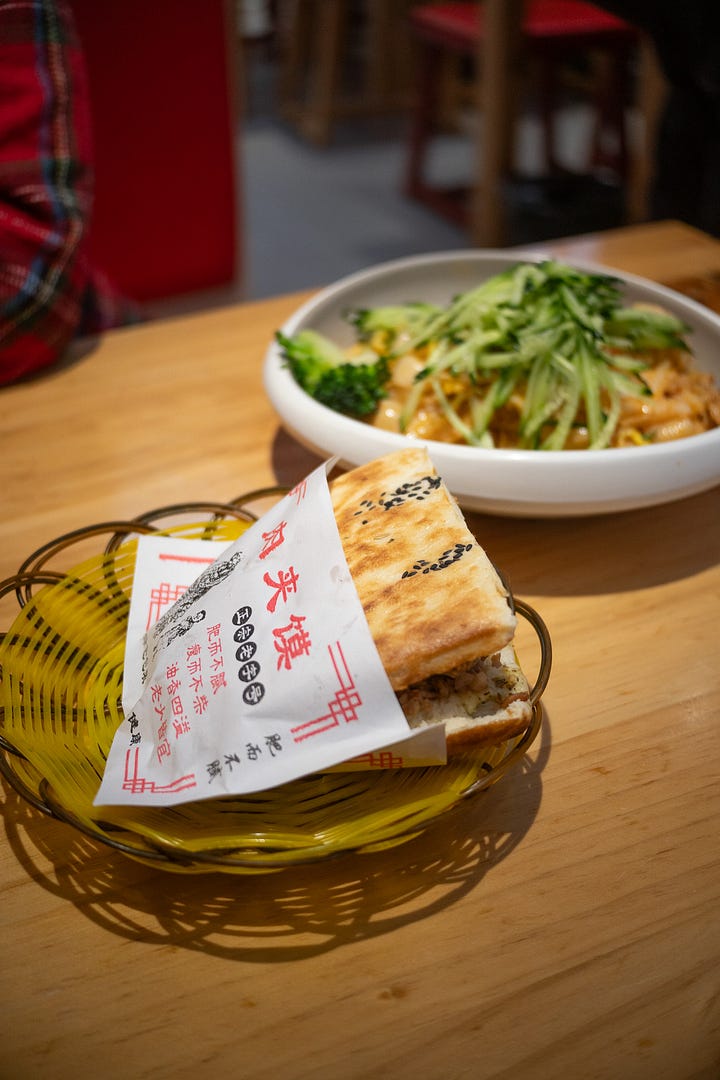
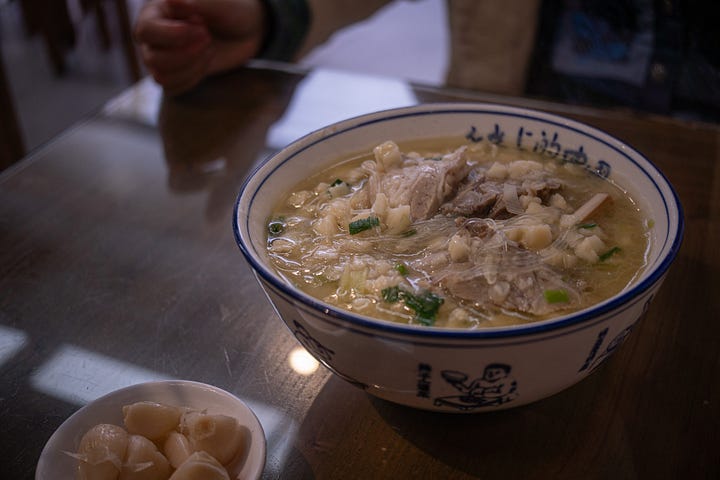


III. Chongqing 重庆
General vibe: bustling, confusing, rather dirty, yet very fascinating city. Observers call it a “three-dimensional” city due to the dramatic topography; all we can really add to the hyperbole is that maps will let you down as they don’t reflect the differences in height. Be prepared to climb a lot of stairs.
Accommodation: We stayed at Zouquye Travel Hostel. If you are not looking for luxury, we highly recommend the place: it is near the Zengjiayan metro station, very cheap, no-frills, and friendly.
Places we recommend:
Hongyadong 洪崖洞: the infamous real-life Spirited Away Bathhouse. Very touristy, yet worth a visit at night to truly grasp what the Chongqing vibe is all about.
Jiefangbei Pedestrian Street 解放碑 - Chongqing Art Museum 重庆美术馆- Kuixing Building: all located near the city’s central area, these are bustling with life, have some beautiful architecture and some famous views of the city.
Liziba 李子坝- Testbed2 二厂: The famous Liziba station where the train passes through a building, while a bit cliche, is still worth seeing. Nearby, you can go to Testbed 2, the city’s youth art and cultural district.
Chongqing Three Gorges Museum: located near the People’s Square (which is grand and pretty), this is a big, detailed, and well-done museum with exhibitions from the Three Gorges dam project to ancient civilizations in Sichuan and porcelain collections. If you visit one museum this is the place to be.
Wulong Karst Park 武隆喀斯特: located 150km away from Chongqing and therefore demand a whopping 6 hours total of our travelling time, this place is totally worth it if you can afford a day trip. The nature is absolutely astounding. Surprisingly easy to get around too: despite the park being very big, there are really nice shuttle bus services.
Chongqing Science and Technology Museum: This one is primarily designed for children, but we had a surprisingly fun time. It’s actually quite fascinating how well-thought-out and extensive Chinese public museums are.
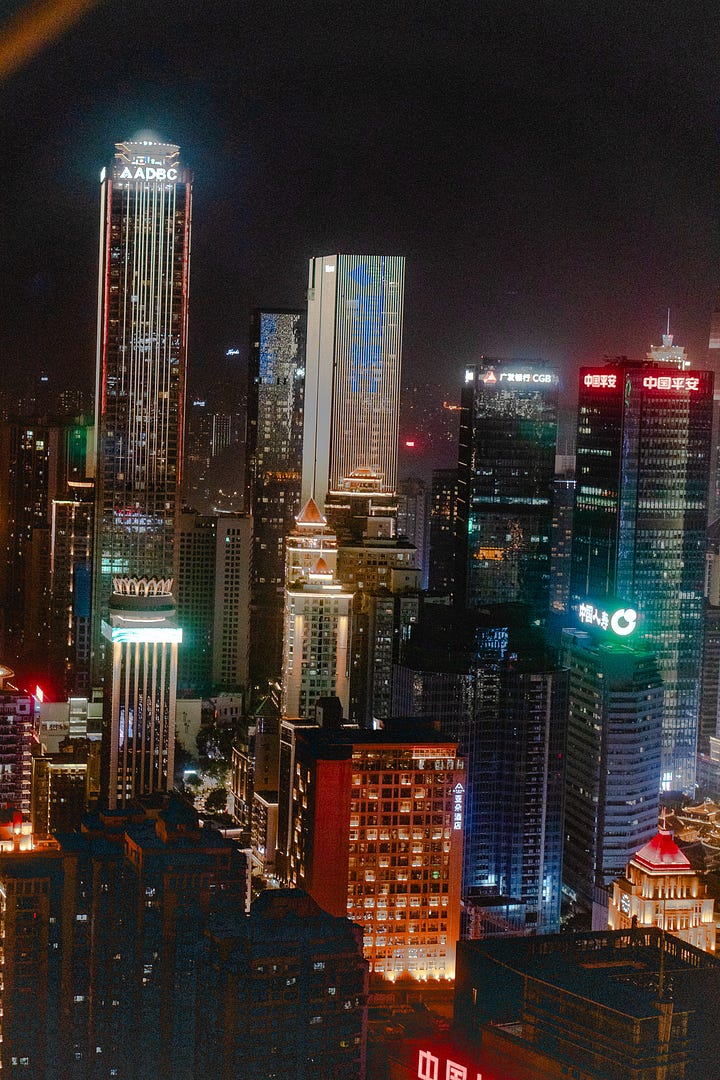
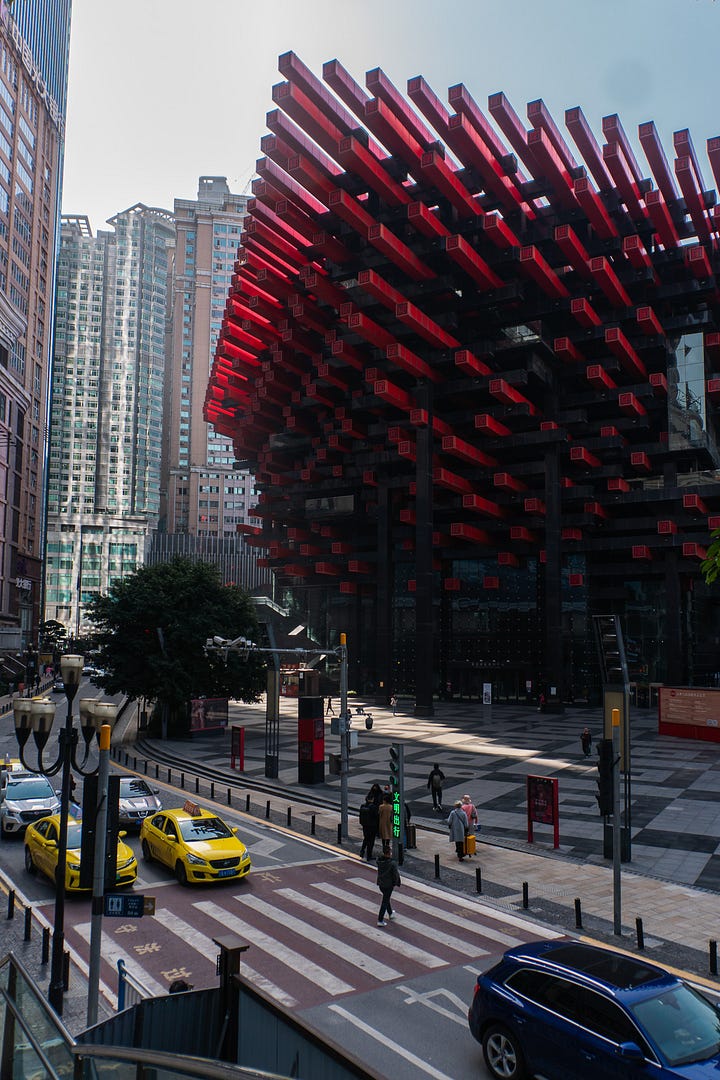


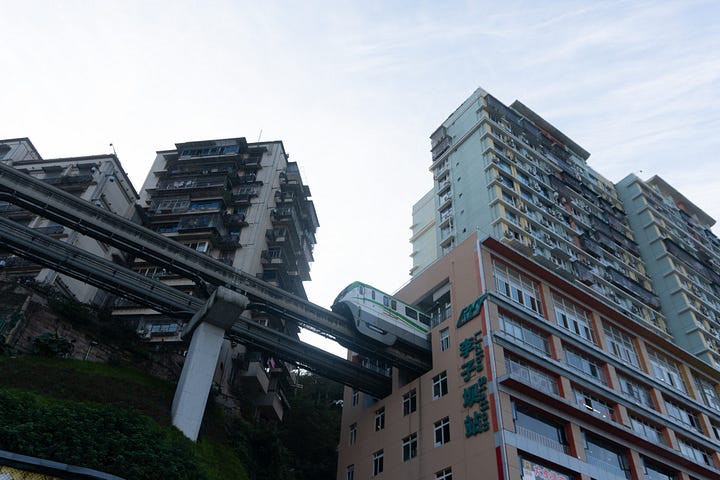
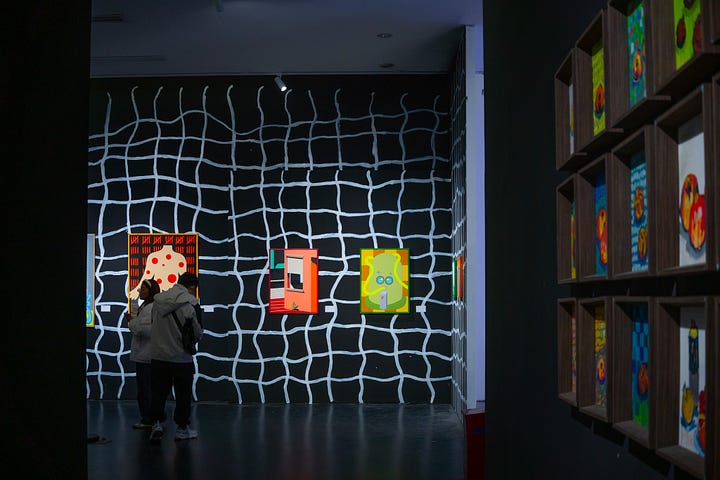

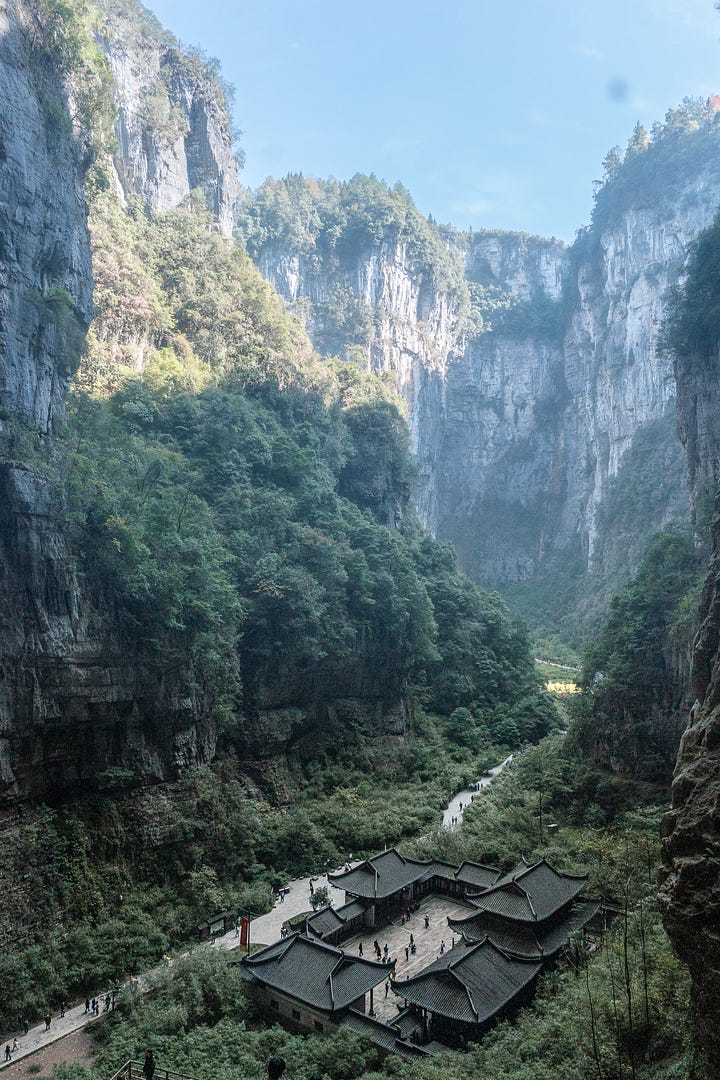
Food to eat:
Chongqing Hot Pot 火锅: They’re everywhere, but our Chongqinger friend Haozhuo told us go a neighborhood joint at Manzuo Huoguo 满座火锅. Chongqing hotpot is spicy, nice and globally famous, what else is to say?
Sichuan sausage 川味香肠: My favorite street snack, which you can also find a lot of in Chengdu. They’re mala-tinged and overall very flavorful and savory compared to the sweeter Guangdong-style sausage.
Noodles/Xiaomian 小面: There is a variety of Xiaomian, noodles with spicy sauce and toppings. More famous ones include Jizamian 鸡杂面 (with chicken offals) and Wanzamian 豌杂面 (with peas and minced meat).
Youcha 油茶: though it reads literally oil-tea, its a porridge with multitudes of toppings and mixed with a nice spicy sauce. A great breakfast or lunch food.
Shaobai 烧白: this is pork belly steamed with meicai - preserved vegetables - with some Sichuan peppercorns, absolutely delicious in a traditional home-style meal. Can also be found in Chengdu.
KFC egg tarts: Yes, they’re in Chongqing too. Can’t have enough.




Hotpot - Wanzamian - Youcha - Homestyle dinner with Shaobai as well as Twice-cooked pork and green chili pork
IV. Chengdu 成都
General vibe: artsy, delicious food, rather relaxed. The most modern and livable out of the three. Also much better English speakers if your Chinese isn’t the best.
Accommodation: Wenjun Courtyard is my favorite hotel out of the three. It’s rather cheap, great service (free laundry, in-house restaurant that is inexpensive and good-tasting, help you book tickets for attractions etc.), and great location. Most of all, the staff are amazing; they speak English, are very attentive, and even sent a delivery driver to the train station when Josh left his earphones behind. Really exceeded our expectations.
Places we recommend:
Chengdu Museum 成都博物馆: Chengdu is a center for art and culture, so the museums are much better curated, better designed, and have better English write-ups too. Chengdu Museum has everything: Chengdu history in ancient China to revolutionary periods, Chengdu folk customs, Chinese puppetry and shadow play. Not to mention, very well designed merchandise and souvenirs.
MuMu Art Gallery Chengdu 木木美术馆: recommended to us by an art manager friend. A very well-managed and professional art space. We went for the Ryuichi Sakamoto exhibition and were thoroughly impressed - probably the best private gallery I’ve visited.
Dufu’s Cottage 杜甫草堂: If you’re interested in Chinese poetry, this is a must-go. if not, it is still a very pretty garden that’s worth a visit. Parks in Chengdu are also very nice in general.
Kuanzhai Alley 宽窄巷子: a gentrified block of pedestrian streets, but a very nice one indeed. You can find everything here: snacks, tea houses, souvenirs, pretty coffeehouses in old temples and synagogues. Probably the best pedestrian streets in our whole trip.
Taikoo Li: a gentrified neighborhood but with high end brands. Good for shopping and enjoying the city’s bustling, youthful vibe.
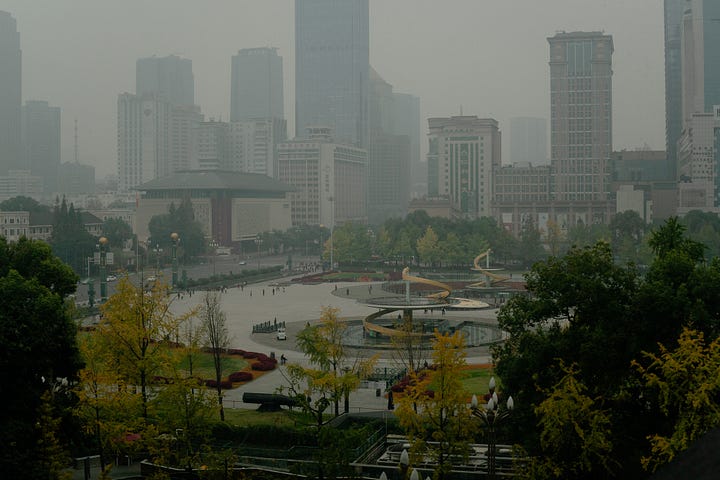
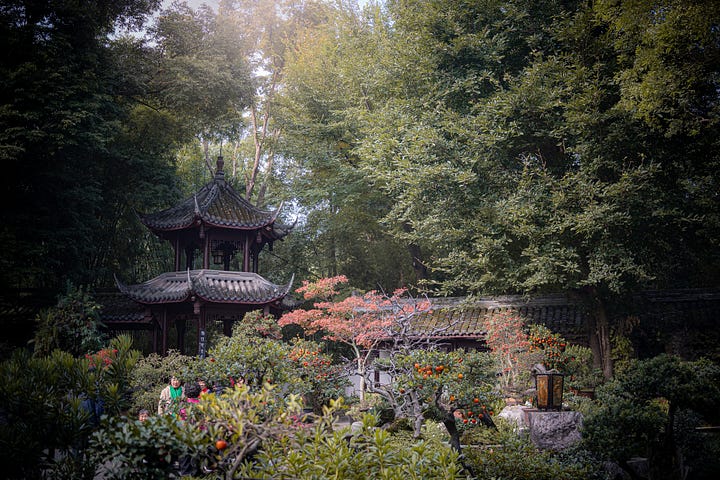
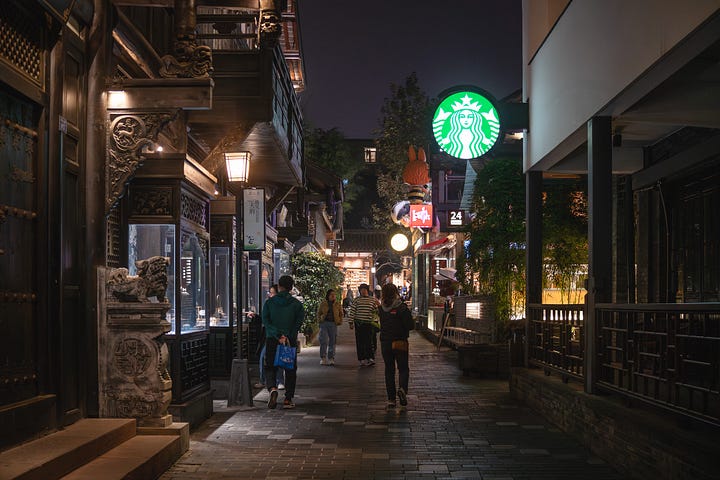
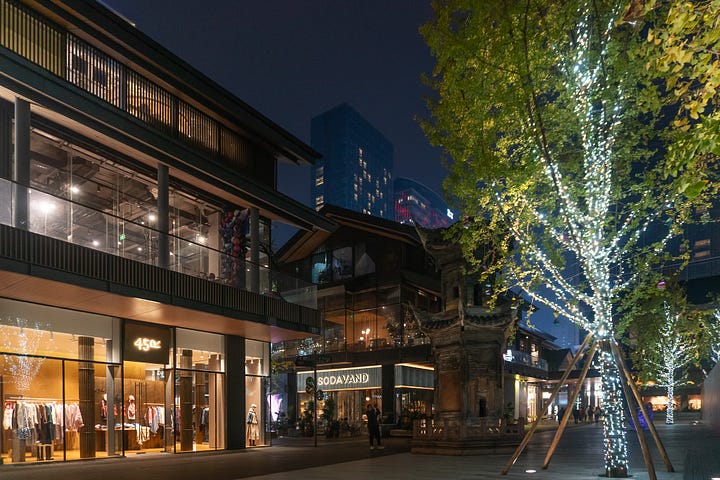
Food to eat:
Sichuan homestyle cuisine 川菜: Don’t go without a full homestyle cuisine dinner: Sichuan food is famous and for good reason. Many dishes can be found this way: Fish in sour vegetables soup 酸菜鱼, Mapo Tofu 麻婆豆腐, Kung Pao Chicken 宫保鸡丁, Twice-cooked Pork 回锅肉, Steamed pork belly with glutinous rice 粉蒸肉, Fried Chicken with Chili 辣子鸡, the list go on and on…
Noodles: There are a variety of good noodles to try, from Dandanmian 担担面 to Zajiangmian 杂酱面/pea noodles with minced meat and Paigumian 排骨面/Noodles with short ribs. You should order weila/less spicy if you want to be safe.
Snacks: For a refreshing small snack, you can have Liangfen 凉粉/cold jelly, which has a white and a yellow variety; Tianshuimian 甜水面/sweet sugary noodles, or Hongtang Bingfen 红糖冰粉/cold jelly with brown sugar. There are multiple good places selling these across town.
Tofu: Lots of restaurants serve Douhua 豆花with a lot of toppings, really refreshing. We got ours at Xiaotan Douhua, highly recommended.
Hotpot: As mentioned above in Chongqing, hotpot is an integral part of Sichuan cuisine. There are many selections, from the more homey joints to big franchises across town.
KFC egg tarts: Oh wait, did we mention this?
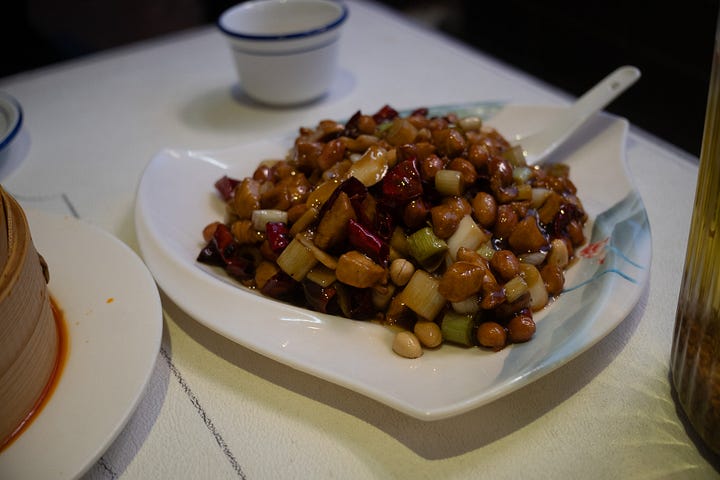


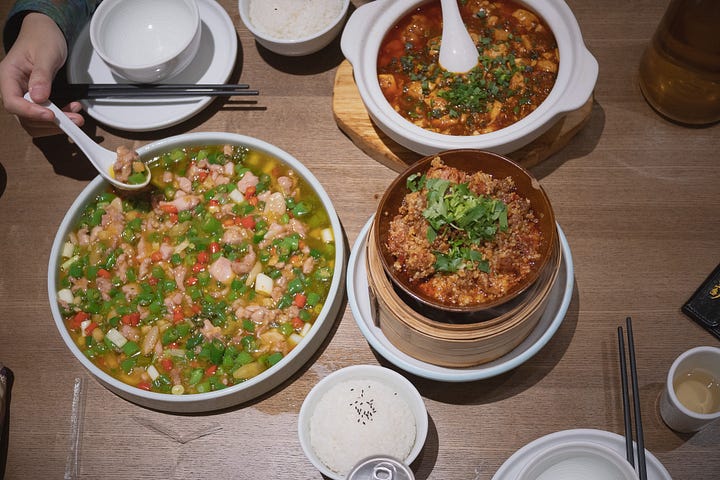
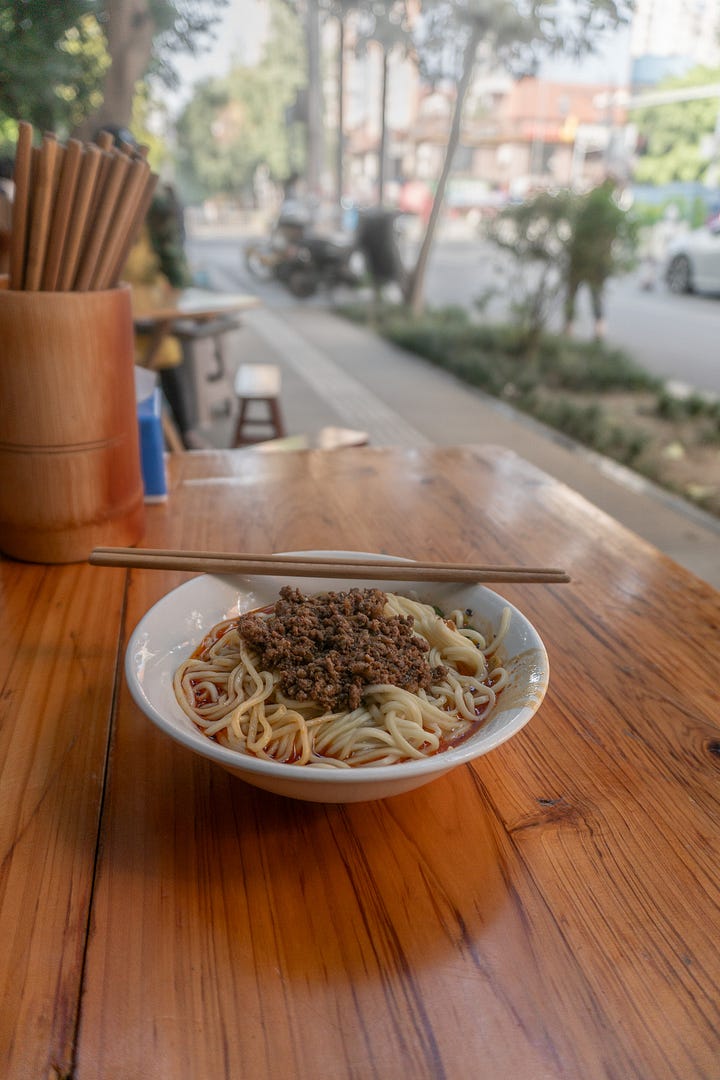
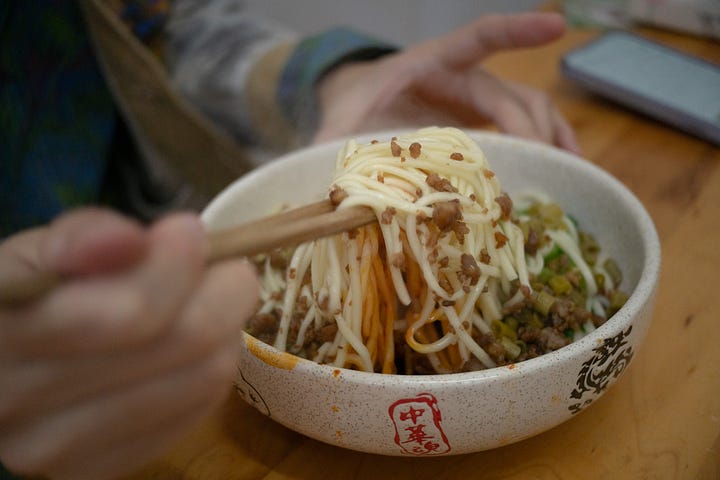
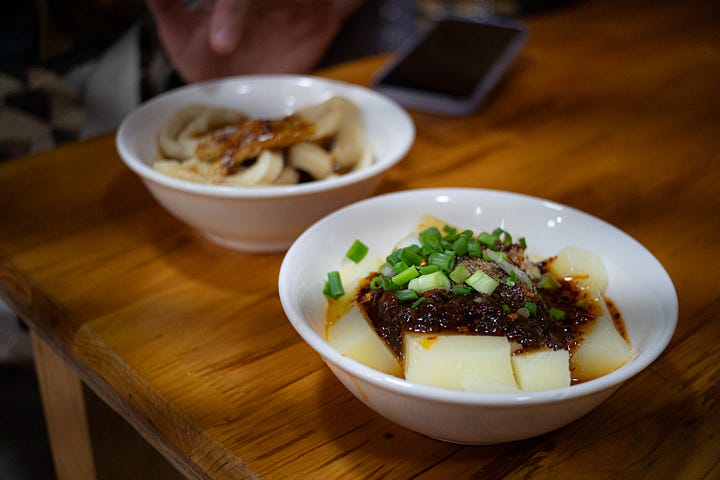
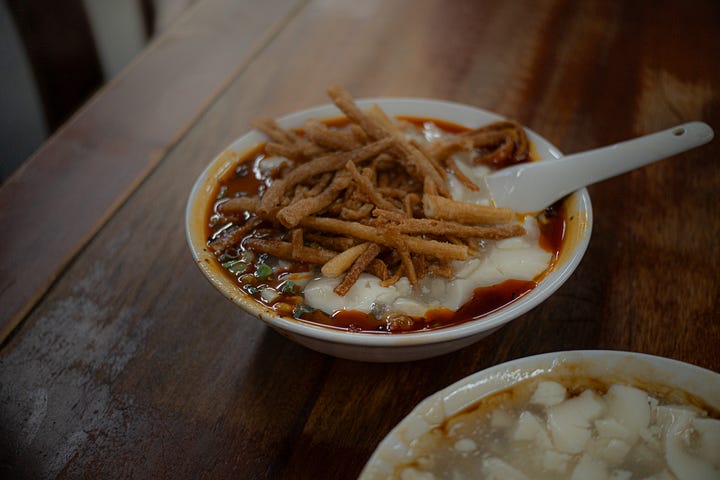
This is nowhere near extensive, just the briefest review of our trip and what might be helpful if you someday also decide to go. The joy of travelling is discovering things by yourself as we go. Although I have been careful to plan out the rough schedule of our trip, it is the most fun to be open to the impromptu decisions that arise along the way, and simply go immerse yourself in the place. After all, this is a vacation, and not a project.
We thoroughly enjoyed our China trip, even though it has not been the easiest at times. The places were amazing, the food were good, and most important of all, I gained a lot of impressions and perspective that I would never be able to attain in Singapore. See you in my China impression series, probably coming out a week or two from now.




